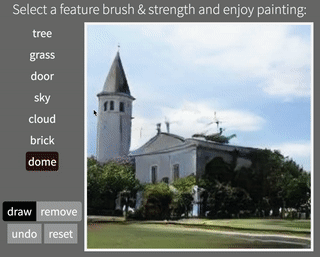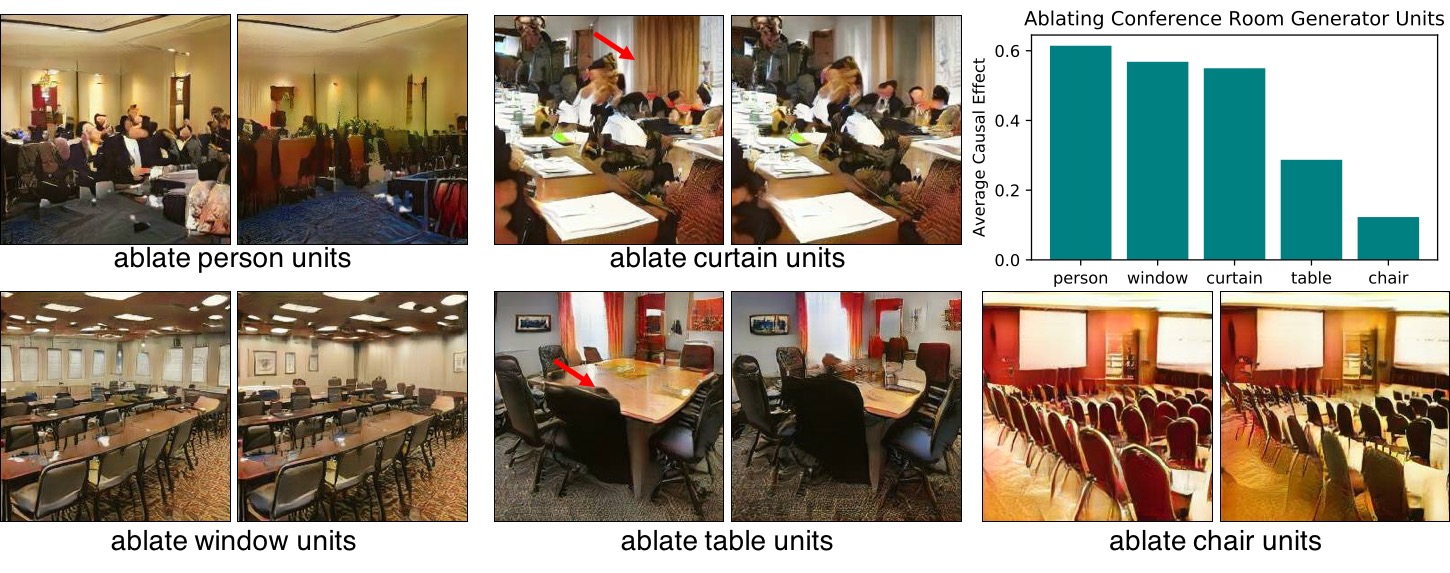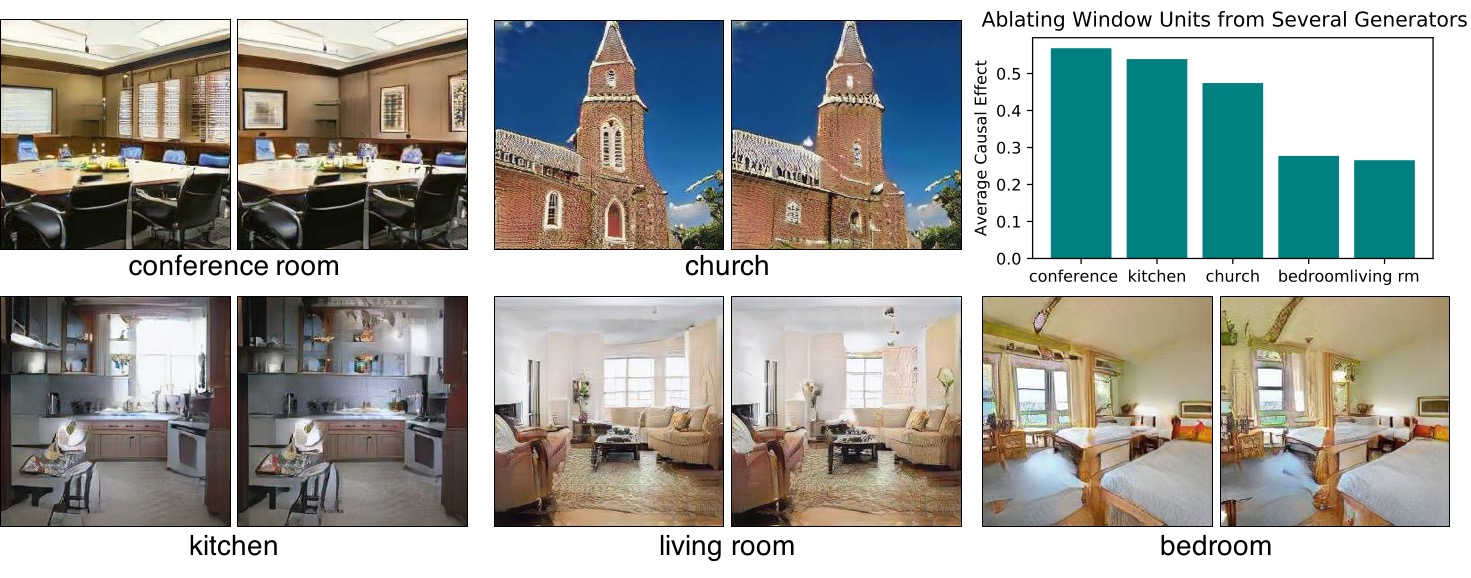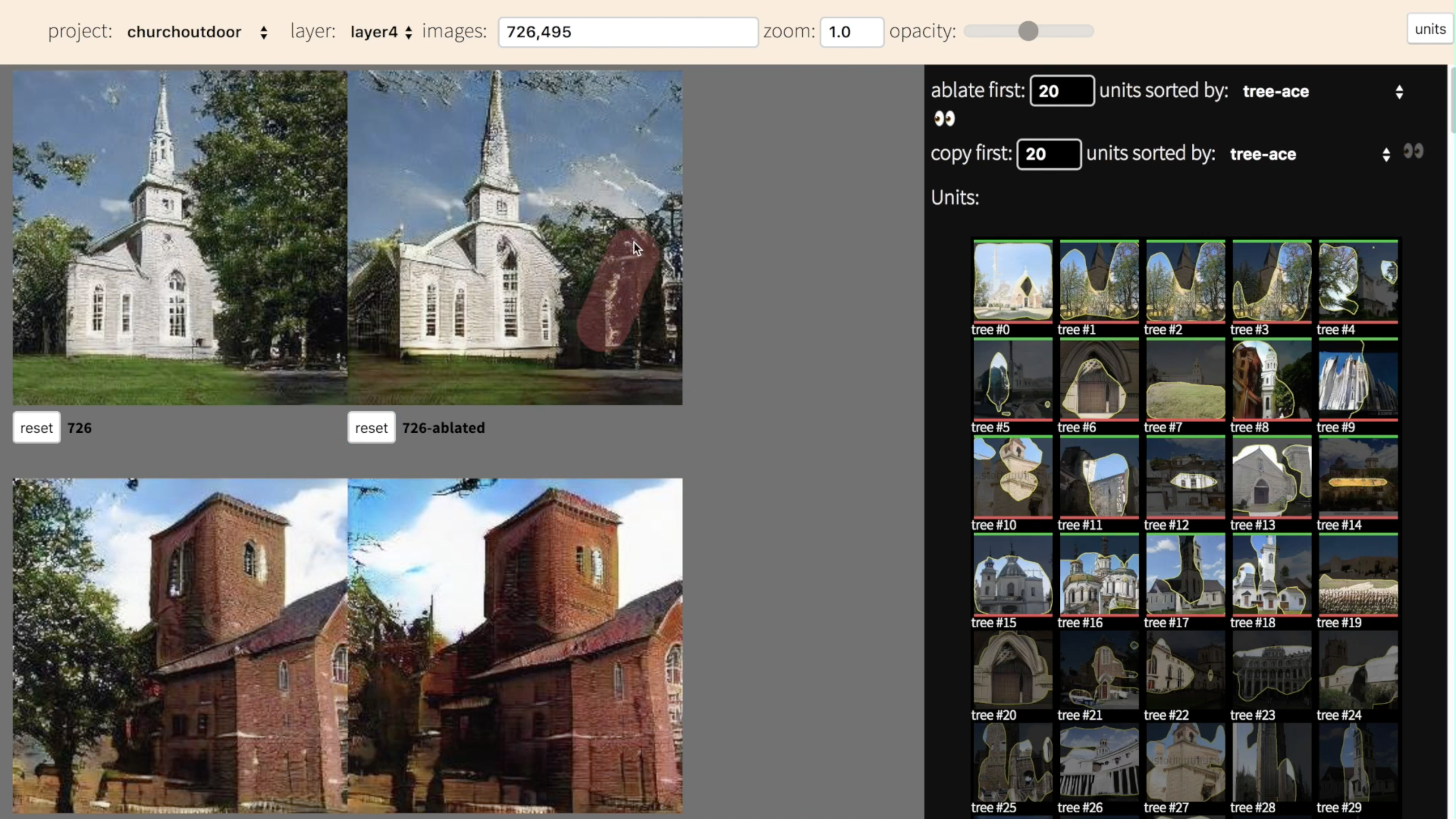GANDissect 
Project | Demo | Paper | Video
GAN Dissection is a way to inspect the internal representations of a generative adversarial network (GAN) to understand how internal units align with human-interpretable concepts. It is part of NetDissect.
This repo allows you to dissect a GAN model. It provides the dissection results as a static summary or as an interactive visualization. Try our interactive GANPaint demo to interact with GANs and draw images.
Overview
Visualizing and Understanding Generative Adversarial Networks
David Bau, Jun-Yan Zhu, Hendrik Strobelt, Bolei Zhou, Joshua B. Tenenbaum, William T. Freeman, Antonio Torralba
MIT CSAIL, MIT-IBM Watson AI Lab, CUHK, IBM Research
In arXiv, 2018.
Analysis and Applications
Interpretable Units in GANs
Analyzing different layers
Diagnosing and improving GANs
Removing objects from conference rooms
Removing windows from different natural scenes
Inserting new objects into images
Release history
v 0.9 alpha - Nov 26, 2018
Getting Started
Let's set up the environment and dissect a churchoutdoor GAN. This requires some CUDA-enabled GPU and some disk space.
Setup
To install everything needed from this repo, have conda available,
and run:
script/setup_env.sh # Create a conda environment with dependencies
script/make_dirs.sh # Create the dataset and dissect directories
script/download_data.sh # Download support data and demo GANs
source activate netd # Enter the conda environment
pip install -v -e . # Link the local netdissect package into the env
Details. The code depends on python 3, Pytorch 4.1, and several other
packages. For conda users, script/environment.yml provides the details
of the dependencies. For pip users, setup.py lists everything needed.
Data. The download_data.sh script downloads the segmentation dataset
used to dissect classifiers, the segmentation network used to dissect GANs,
and several example GAN models to dissect. The downloads will go into
the directories dataset/ and models/. If you do not wish to download
the example networks, python -m netdissect --download will download
just the data and models needed for netdissect itself.
Dissecting a GAN
GAN example: to dissect three layers of the LSUN living room progressive GAN trained by Karras:
python -m netdissect \
--gan \
--model "netdissect.proggan.from_pth_file('models/karras/livingroom_lsun.pth')" \
--outdir "dissect/livingroom" \
--layer layer1 layer4 layer7 \
--size 1000
The result is a static HTML page at dissect/livingroom/dissect.html, and
a JSON file of metrics at dissect/livingroom/dissect.json.
You can test your own model: the --model argument is a fully-qualified
python function or constructor for loading the GAN to test. The
--layer names are fully-qualified (state_dict-style) names for layers.
By default, a scene-based segmentation is used but a different segmenter class
can be substituted by supplying an alternate class constructor to
--segmenter. See netdissect/segmenter.py for the segmenter base class.
Running a GAN editing server (alpha)
Once a GAN is dissected, you can run a web server that provides an API that generates images with (optional) interventions.
python -m netdissect.server --address 0.0.0.0
The editing UI (right) is served at http://localhost:5001/ .
Other URLs:
- http://localhost:5001/api/ui is the OpenAPI/swagger UI for directly testing GAN interventions.
- http://localhost:5001/data/livingroom/dissect.html static net dissection reports.
- http://localhost:5001/data/livingroom/edit.html a dissection-based interface for testing interventions.
- TODO: http://localhost:5001/ganpaint.html will serve GANpaint
Advanced Level
Dissecting a classifier (NetDissect)
Classifier example: to dissect three layers of the pretrained alexnet in torchvision:
python -m netdissect \
--model "torchvision.models.alexnet(pretrained=True)" \
--layers features.6:conv3 features.8:conv4 features.10:conv5 \
--imgsize 227 \
--outdir dissect/alexnet-imagenetNo special web server for a classifier.
Command Line Details
Documentation for the netdissect command-line utility.
usage: python -m netdissect [-h] [--model MODEL] [--pthfile PTHFILE]
[--outdir OUTDIR] [--layers LAYERS [LAYERS ...]]
[--segments SEGMENTS] [--segmenter SEGMENTER]
[--download] [--imgsize IMGSIZE]
[--netname NETNAME] [--meta META [META ...]]
[--examples EXAMPLES] [--size SIZE]
[--batch_size BATCH_SIZE]
[--num_workers NUM_WORKERS]
[--quantile_threshold {[0-1],iqr}] [--no-labels]
[--maxiou] [--covariance] [--no-images]
[--no-report] [--no-cuda] [--gen] [--gan]
[--perturbation PERTURBATION] [--add_scale_offset]
[--quiet]
optional arguments:
-h, --help show this help message and exit
--model MODEL constructor for the model to test
--pthfile PTHFILE filename of the .pth file for the model
--outdir OUTDIR directory for dissection output
--layers LAYERS [LAYERS ...]
space-separated list of layer names to dissect, in the
form layername[:reportedname]
--segments SEGMENTS directory containing segmentation dataset
--segmenter SEGMENTER
constructor for a segmenter class
--download downloads Broden dataset if needed
--imgsize IMGSIZE input image size to use
--netname NETNAME name for the network in generated reports
--meta META [META ...]
json files of metadata to add to report
--examples EXAMPLES number of image examples per unit
--size SIZE dataset subset size to use
--batch_size BATCH_SIZE
batch size for a forward pass
--num_workers NUM_WORKERS
number of DataLoader workers
--quantile_threshold {[0-1],iqr}
quantile to use for masks
--no-labels disables labeling of units
--maxiou enables maxiou calculation
--covariance enables covariance calculation
--no-images disables generation of unit images
--no-report disables generation report summary
--no-cuda disables CUDA usage
--gen test a generator model (e.g., a GAN)
--gan synonym for --gen
--perturbation PERTURBATION
the filename of perturbation attack to apply
--add_scale_offset offsets masks according to stride and padding
--quiet silences console output
API, for classifiers
It can be used from code as a function, as follows:
- Load up the convolutional model you wish to dissect, and call
imodel = InstrumentedModel(model)and thenimodel.retain_layers([layernames,..])to instrument the model. - Load the segmentation dataset using the BrodenDataset class;
use the
transform_imageargument to normalize images to be suitable for the model, and thesizeargument to truncate the dataset. - Choose a directory in which to write the output, and call
dissect(outdir, imodel, dataset).
A quick approximate dissection can be done by reducing the size
of the BrodenDataset. Generating example images can be time-consuming
and the number of images can be set via examples_per_unit.
Example:
from netdissect import InstrumentedModel, dissect
from netdissect import BrodenDataset
model = InstrumentedModel(load_my_model())
model.eval()
model.cuda()
model.retain_layers(['conv1', 'conv2', 'conv3', 'conv4', 'conv5'])
bds = BrodenDataset('dataset/broden1_227',
transform_image=transforms.Compose([
transforms.ToTensor(),
transforms.Normalize(IMAGE_MEAN, IMAGE_STDEV)]),
size=10000)
dissect('result/dissect', model, bds,
batch_size=100,
examples_per_unit=10)
The Broden dataset is oriented towards semantic objects, parts, material, colors, etc that are found in natural scene photographs.
If you want to analyze your model with a different semantic segmentation, you can substitute a different segmentation dataset and supply a segrunner, an argument that describes how to get segmentations and RGB images from the dataset. See ClassifierSegRunner for the details.
API, for generators
Similarly:
- Load up the generator model wish to dissect, and call
retain_layers(model, [layernames,..])to instrument the model. - Create a dataset of z input samples for testing. If your model uses a uniform normal distribution, z_dataset_for_model will make one.
- Choose a directory in which to write the output, and call
dissect(outdir, model, dataset, segrunner=GeneratorSegRunner()).
The time for the dissection is proportional to the number of samples in the dataset.
from netdissect import InstrumentedModel, dissect
from netdissect import z_dataset_for_model, GeneratorSegRunner
model = InstrumentedModel(load_my_model())
model.eval()
model.cuda()
model.retain_layers(model, ['layer3', 'layer4', 'layer5'])
zds = z_dataset_for_model(size, model)
dissect('result/gandissect', model, zds,
segrunner=GeneratorSegRunner(),
batch_size=100,
examples_per_unit=10)
The GeneratorSegRunner defaults to a running a semantic segmentation network oriented towards semantic objects, parts, and materials found in natural scene photographs. To use a different semantic segmentation, you can supply a custom Segmenter subclass to the constructor of GeneratorSegRunner.
Citation
If you use this code for your research, please cite our paper:
@article{bau2018gandissect,
title={GAN Dissection: Visualizing and Understanding Generative Adversarial Networks},
author={Bau, David and Zhu, Jun-Yan and Strobelt, Hendrik and Zhou Bolei and Tenenbaum, Joshua B. and Freeman, William T. and Torralba, Antonio},
journal={arXiv preprint arXiv:1811.10597},
year={2018}







